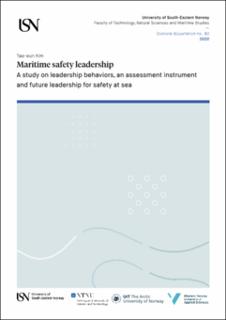| dc.description.abstract | Despite continual technological advancements and heightened safety standards in the merchant shipping industry, catastrophic accidents in recent years (e.g., Sanchi, Sewol ferry, Costa Concordia) have again reminded the world of the importance of safety in this industry. Investigation into maritime accidents has often revealed limited technical malfunctions but a series of organizational, managerial and leadership issues that influenced the safety culture and enabled the system to drift toward a state of higher risk.
Achieving and sustaining a safe workplace demands right and strong leadership. Considering the research conducted in various high-risk industrial settings (e.g., aviation, nuclear, healthcare, coal mining), the importance of leadership on safety has been well acknowledged and studied for many years (as elaborated in Section 2.3 and Table 8). However, there has been limited crossover of this body of work into the maritime arena. A leadership style characterized by a primary focus on promoting safety—safety leadership—has not been thoroughly explored in the maritime context. The current research lacks empirically tested theoretical models—with a validated and reliable scale—for describing and measuring safety leadership in daily operations. This, in turn, has limited our theoretical understanding and practice of maritime safety leadership.
In light of this knowledge gap, this thesis is carried out through a series of individual studies, with a total of 517 respondents from various merchant shipping sectors, aiming to explore and understand the safety leadership phenomenon in this context. This thesis presents five research articles, as briefly introduced in the following Figure (1). Article 1 is a background study to this PhD work, conducted to gain insights into maritime accidents and to understand the importance of human and organizational influences in maritime safety. Articles 2 and 3 are empirical studies that focus on exploring the effective safety leadership behaviors and influence tactics of shipboard officers. By considering the results derived from these two empirical studies, Article 4 focuses on developing the first Safety Leadership Self-Efficacy Scale (SLSES) in the merchant shipping context. The SLSES is developed through sequentially applying three interdependent analytical processes. Taken together, these empirical studies have resulted in a weighted model incorporating key safety leadership behavioral categories and a safety leadership measurement scale that may facilitate the maritime researchers and practitioners to better understand, exercise and train safety leadership.
As global shipping sails into a more autonomous future, Article 5 presents an empirical analysis regarding if and how the leadership model will be changed in the future era of shipping. It identifies and prioritizes the leadership competences that should be developed by the personnel involved in autonomous ship operations. Each of these articles presents an independent but interlinked study supported by a variety of qualitative and/or quantitative research methods.
Amid all the pressing priorities in today’s shipping business, the safety of the crews, passengers, cargos and ocean are the foremost moral and ethical obligations. It is one of the ultimate duties as well as challenges of today’s leaders to effectively manage technology and lead people for safe and efficient ship operations. This thesis explored safety leadership behaviors and an assessment instrument as well as future leadership for safety at sea. The outcomes of this research have the following theoretical, policy and practical contributions to the maritime safety leadership field.
First, the thesis contributes to bridging a gap in the safety leadership literature, specifically the lack of an overall understanding of safety leadership in the maritime domain. It extends the existing safety leadership knowledge on how specific leaders’ behaviors might affect subordinates’ safety-related activities. It also provides an initial clarification regarding the leadership behaviors that are likely to motivate and promote different aspects of subordinates’ safety behaviors. It further identifies which of these leadership behaviors is likely to have the most important impact on safety performance in ship operations.
Second, a measurement scale, the Safety Leadership Self-Efficacy Scale (SLSES), is formulated to serve as an instrument to facilitate an understanding of the safety leadership performance or potential of the current and future shipboard officers. Without measurement, we will have no visibility over performance and no direction for improvement. The SLSES formulated in this thesis contains 24 measurement items and three dimensions, including shipboard leaders’ efficacy in safety management, motivation facilitation and safety initiatives. The scale can be used in practice by shipboard leaders to diagnose their own safety leadership levels, by subordinates to assess their leader’s safety leadership performance, or by Maritime Education and Training (MET) institutes to perform more objective performance assessments. To the best of the author’s knowledge, such an initiative is innovative in the current maritime safety leadership literature.
Third, no research to date has explored the impact of autonomous shipping on leadership behaviors and the leadership competence requirements specified on the International Convention on Standards of Training, Certification and Watchkeeping for Seafarers (STCW), 1978, as amended. Article 5 of this thesis took the initiative to explore if the disruptive changes with regard to implementing Maritime Autonomous Surface Ships (MASS) will influence safety leadership behaviors and STCW leadership competence requirements. The results have shown that the current STCW leadership framework is not fully relevant for MASS. The leadership competences that should be accrued by the personnel involved in autonomous ship operations were discussed and prioritized according to their relative importance for safe operations under two different configurations of MASS.
This thesis could have policy implications for STCW Table A-II/2 (for masters and chief mates), Table A-III/2 (for chief engineer officers and second engineer officers), Table A-II/1 (for officers in charge of a navigational watch) and Table A-III/1 (for officers in charge of an engineering watch), as well as other tables that specify the same leadership Knowledge, Understanding and Proficiency (KUP). The results could contribute to professional seafarers, policy-makers and MET institutes interested in improving leadership training as well as other non-technical skill development programs. The findings generated and presented in this thesis may also, hopefully, shed light on further thoughts and research discussions for improving the safety of future ship operations. | en_US |
